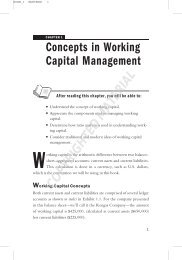ISSUE 5 2008 - Sweet & Maxwell
ISSUE 5 2008 - Sweet & Maxwell
ISSUE 5 2008 - Sweet & Maxwell
You also want an ePaper? Increase the reach of your titles
YUMPU automatically turns print PDFs into web optimized ePapers that Google loves.
Crim. L.R. Cases 409<br />
Global Digest<br />
Compiled by: Andrew J. Roberts, LL.B., M.Phil.<br />
Video Reconstruction—Jury Directions—Australia<br />
Mahmood v State of Western Australia [<strong>2008</strong>] HCA 1<br />
Australia; Judicial comment; Jury directions; Murder; Re-enactments; Video<br />
evidence<br />
The appellant had been convicted of the murder of his wife. In a police interview<br />
he claimed to have become suspicious when she failed to return from the toilet at<br />
the restaurant which they ran. He explained that when he went to see where she<br />
was, he found her body at the rear of the premises. Her throat had been cut. One<br />
week after being interviewed by the police, the appellant agreed to re-enact the<br />
events surrounding the discovery of the body. He accompanied the police to the<br />
restaurant and ‘‘walked through’’ the events of the day and described the position<br />
in which he had found the body and the manner in which he had handled it.<br />
The prosecution’s case against the appellant was circumstantial: no murder<br />
weapon had been found; the appellant had suspected his wife of having an affair<br />
and had hired a private detective to investigate matters; there was evidence that<br />
raised voices had been heard in the restaurant on the morning of the murder.<br />
Expert witnesses were called to give evidence regarding the location of blood at the<br />
premises.<br />
The defence relied on a six-minute sequence of the video recorded re-enactment<br />
in which the appellant explained how he had held his wife’s body. Although defence<br />
counsel indicated a willingness to tender the whole of the video, the prosecution<br />
did not consent to such a course. However, in his closing address to the jury,<br />
prosecution counsel drew attention to the appellant’s demeanour during the sixminute<br />
video sequence played at trial. The jury were invited to consider whether<br />
the appellant had shown any emotion when he was asked about the blood and<br />
were invited to infer that his demeanour was that of someone who had committed<br />
a cold-blooded and clinical murder. In light of this, defence counsel applied to<br />
reopen the case for the defence so that the jury could be shown the recording in<br />
its entirety. This application was refused and the trial judge dealt with the issue<br />
in her summing-up in which she subsequently suggested to the jury that that it<br />
would be ‘‘unwise’’ to draw any adverse inferences against the accused because of<br />
his demeanour during the video recording.<br />
On appeal against conviction, it was common ground that the appellant had<br />
displayed distress and appeared to have been emotionally upset when talking about<br />
his wife at several points in the parts of the video recording which had not been<br />
shown to the jury. The High Court, allowing the appeal, concluded that in order<br />
to overcome the prejudicial effects of the prosecutors remarks it would have been<br />
© SWEET &MAXWELL






